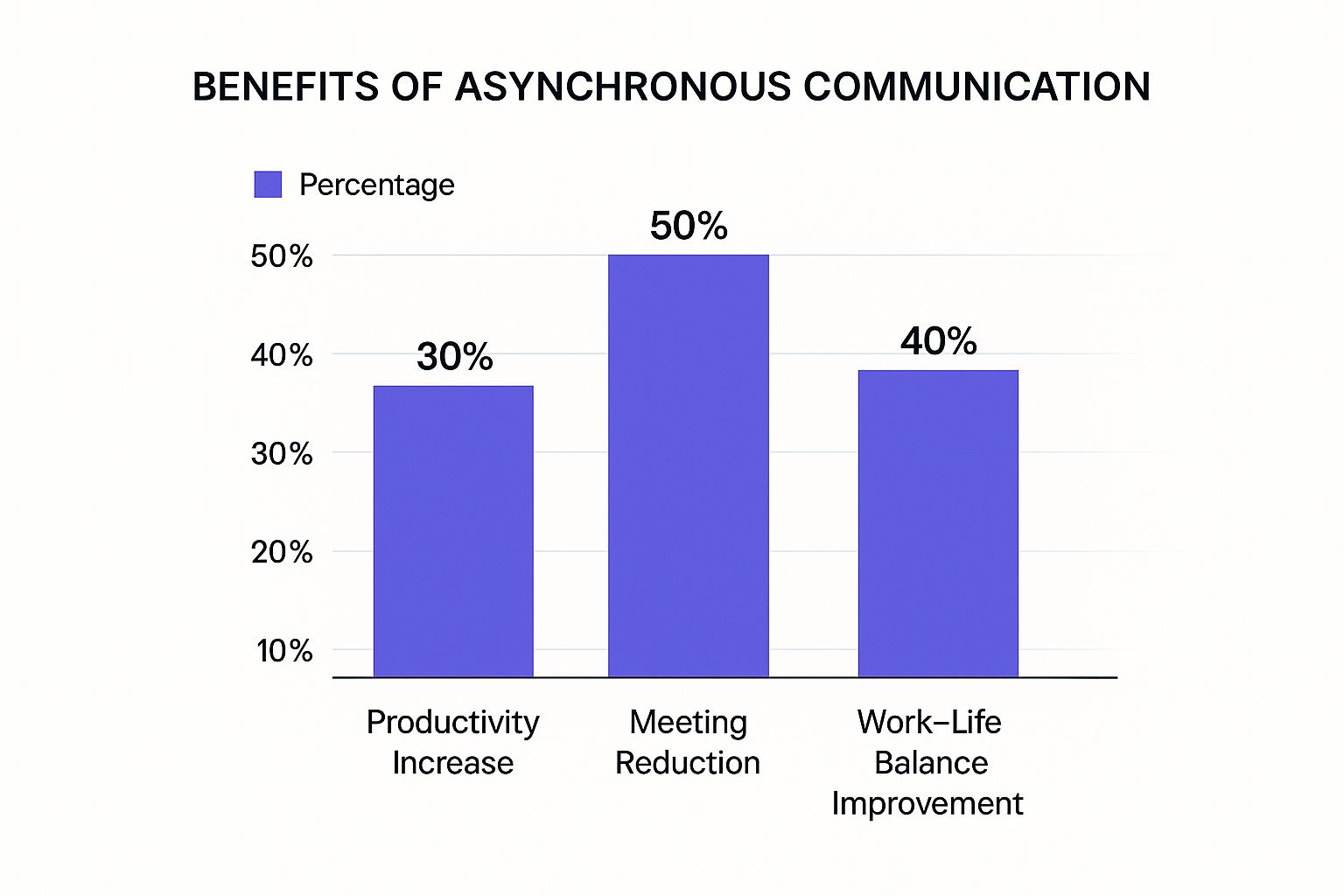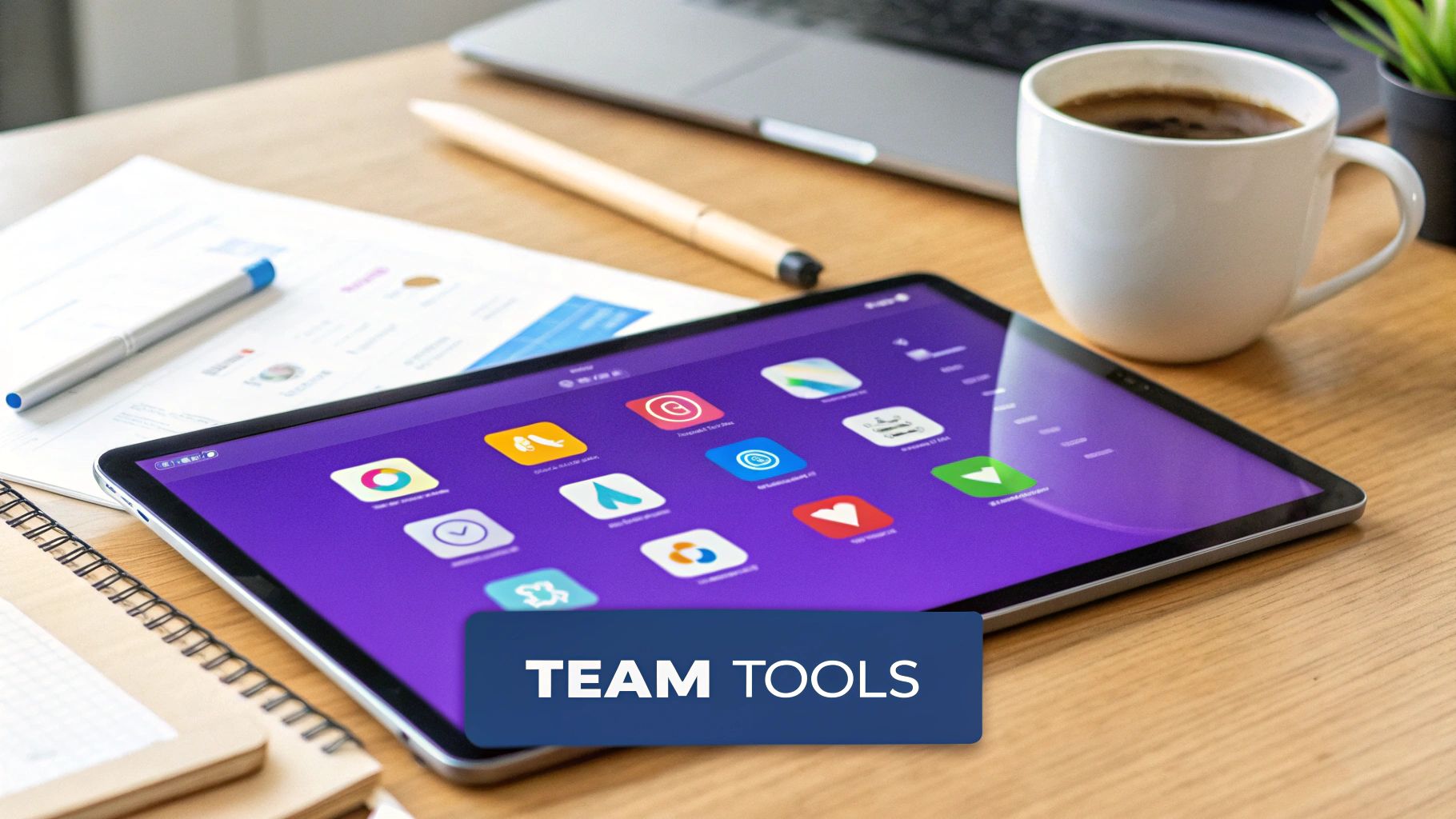The Asynchronous Advantage: Why Teams Are Breaking Free from Sync

The traditional 9-to-5 workday, where everyone works simultaneously, is becoming a thing of the past. A new model is taking its place: the asynchronous team. This shift represents a fundamental change in how teams collaborate, communicate, and achieve success. Why are so many teams embracing this new way of working?
Flexibility and Focus: Empowering Individual Contributors
One of the biggest advantages of asynchronous work is the flexibility it provides. Team members can work when they're most productive, whether that's early in the morning, late at night, or any time in between. This flexibility allows for deep work, those uninterrupted periods crucial for innovation and problem-solving.
Asynchronous teams also empower individuals to manage their own time. This can lead to a better work-life balance and less stress. It's interesting to consider how asynchronous work complements other flexible work arrangements, like the 4-day work week, as discussed in this article: Balancing Sync and Async in a 4-Day Week. This increased flexibility can lead to a more engaged and motivated team.
Inclusivity and Diversity: Harnessing Global Talent
Asynchronous teams are naturally more inclusive. They eliminate geographical barriers, allowing organizations to access a global talent pool. For instance, team members in different time zones can contribute effectively to the same project, each working during their preferred hours.
This not only expands the available talent pool but also brings diverse perspectives to projects, enriching the work itself. Asynchronous communication promotes more thoughtful and considered contributions, ensuring everyone's voice is heard.
Efficiency and Productivity: Minimizing Disruptions
Meetings are a common productivity killer. Asynchronous communication lessens the need for frequent meetings, freeing up valuable time for focused work. Instead of interrupting everyone's workflow for a synchronous discussion, updates and decisions can be shared through tools like project management platforms, shared documents, and messaging apps.
This streamlined approach minimizes distractions and keeps projects moving forward efficiently. Asynchronous collaboration is becoming a key element of modern team management. This trend is likely to grow, with businesses investing more in tools that support asynchronous communication and knowledge sharing across different time zones. You can learn more about the future of remote work here: Find more detailed statistics here. This investment in asynchronous tools reflects a broader move toward more flexible and results-driven work cultures.
Evolution Unleashed: How Asynchronous Teams Are Reshaping Work

The infographic above highlights the potential of asynchronous communication. It shows significant improvements in areas like productivity, meeting frequency, and work-life balance. Asynchronous teams are more than just a passing trend; they represent a real shift in how we approach work.
This move away from traditional, synchronous models towards more flexible options is fueled by a few key factors. These include advancements in technology and the evolving demographics of the modern workforce. The desire for better work-life balance is a major driver.
As of 2024, approximately 20% of U.S. workers were remote. And this number is only expected to climb. Projections suggest that up to 32.6 million Americans will be working from home by 2025. Find more detailed statistics here. This transition is reshaping industries and changing our understanding of team productivity.
The data reveals a clear link between asynchronous work and positive outcomes. Reported benefits include a 30% increase in productivity, a 50% reduction in meetings, and a 40% improvement in work-life balance.
From Niche To Norm: The Rise of Asynchronous Work
Asynchronous teams were once a niche concept, often adopted out of necessity by globally distributed companies or those with employees across multiple time zones. However, the advantages of this model – like increased productivity, improved work-life balance, and access to a broader talent pool – quickly became clear.
This realization sparked wider adoption of asynchronous practices, even within teams sharing the same physical location. You might find this resource helpful: How to master fostering innovation in remote teams. The transition wasn't always smooth. Initial resistance came from concerns about communication breakdowns, lack of oversight, and the perceived difficulty of building strong team cohesion.
Let's take a look at some interesting statistics showcasing the rise of remote work and its relationship to asynchronous team models.
The following table, "Remote Work Adoption Trends," provides a snapshot of this shift:
| Year | Remote Workers (%) | Companies with Async Policies (%) | Reported Productivity Impact |
|---|---|---|---|
| 2020 | 16 | 10 | +15% |
| 2021 | 18 | 15 | +20% |
| 2022 | 19 | 18 | +25% |
| 2023 | 20 | 22 | +28% |
| 2024 | 22 (Projected) | 25 (Projected) | +30% (Projected) |
As you can see, the adoption of remote work and asynchronous policies has steadily increased, along with reports of improved productivity. This trend is likely to continue in the coming years.
Overcoming Challenges and Embracing Change
As technology advanced and best practices emerged, many initial concerns about asynchronous work were addressed. Tools like project management platforms and collaborative workspaces facilitated seamless communication and efficient workflow management.
These advancements allowed teams to stay aligned, track progress, and make decisions effectively, regardless of their location or time zone. The rise of remote work during the pandemic further solidified the viability of asynchronous practices on a large scale.
Our internal experiment with a 4-day week highlighted the importance of balancing both synchronous and asynchronous communication in team settings. You can learn more about this balance here: Balancing Sync and Async in a 4-Day Week.
The Future of Work: Asynchronous and Agile
Today, leading organizations across various industries are using asynchronous models to gain a competitive edge. By offering greater flexibility, they attract and retain top talent, fostering more inclusive work environments and unlocking new levels of productivity.
This evolution isn't just about where work happens, but how it gets done. Asynchronous teams often embrace agile methodologies, emphasizing iterative progress, continuous feedback, and rapid adaptation to change. This focus on outcomes over presenteeism further cements asynchronous teams as the future of work.
The Digital Backbone: Essential Tools That Power Async Teams

Asynchronous teams rely on technology to bridge the geographical distance and differing schedules. Choosing the right tools is key for smooth collaboration and efficient work. This creates a digital backbone that supports the entire team structure. The focus should be on platforms that promote clarity and visibility without adding unnecessary complexity.
Communication Tools: Keeping Everyone Connected
Effective communication is crucial for any team, but even more so for those working asynchronously. The right tools can make the difference between clear communication and an overwhelming flood of messages.
-
Instant Messaging: Tools like Slack or Microsoft Teams allow for quick communication. These are perfect for daily updates and informal chats, supporting direct messages and channel-based conversations for focused project discussions.
-
Video Conferencing: While asynchronous teams generally minimize meetings, occasional video calls can be helpful. Tools like Zoom or Google Meet are useful for team building and tackling complex issues together.
-
Email: Email is still important for formal announcements, detailed updates, and communicating with people outside the team. It’s a structured way to share information and keep track of decisions.
Project Management and Task Tracking
Asynchronous teamwork needs clear visibility into who is responsible for what, and when. Good project management tools provide this much-needed transparency.
-
Project Management Platforms: Platforms like Asana, Trello, or Monday.com are central hubs for managing tasks, tracking projects, and visualizing progress. Teams can break down projects into smaller tasks, assign owners, set deadlines, and monitor progress—all in one place. You might be interested in: How to master remote team management software.
-
Shared Documents and Files: Cloud storage like Google Drive or Dropbox is vital for storing and sharing files, making sure everyone has access to the latest versions.
Documentation and Knowledge Management
Asynchronous teams can sometimes struggle with information getting siloed. Good documentation ensures that everyone can easily find and access the knowledge they need.
-
Knowledge Bases: Tools like Notion or Confluence allow teams to create central repositories for team knowledge, project documentation, and meeting notes.
-
Wiki Platforms: Internal wikis serve as dynamic documentation hubs where team members can contribute to and update information together.
Avoiding Tool Fatigue: Choosing Wisely
While these tools are powerful, using too many can lead to tool fatigue and information overload. The key is to pick a core set of tools that meet your team's specific needs and work well together. For example, choose a project management platform that integrates with your communication tools and file storage to simplify workflows and reduce app switching. Clear guidelines on how and when each tool should be used can prevent confusion and maximize efficiency.
The following table provides a quick comparison of several asynchronous communication and project management tools.
To help navigate the variety of tools available, we've put together a comparison table:
Asynchronous Team Tool Comparison
Comprehensive comparison of top tools for asynchronous team communication and project management
| Tool | Best For | Key Features | Pricing | Integration Capabilities | Learning Curve |
|---|---|---|---|---|---|
| Slack | Instant communication & team collaboration | Channels, direct messaging, file sharing, search | Free & paid plans | Extensive | Easy |
| Microsoft Teams | Communication, collaboration, & video conferencing | Chat, meetings, file storage, app integrations | Free & paid plans | Excellent with Microsoft products | Easy to moderate |
| Asana | Project & task management | Task assignments, deadlines, progress tracking, Kanban boards | Free & paid plans | Wide range | Moderate |
| Trello | Visual project management | Kanban boards, lists, cards, collaboration features | Free & paid plans | Many integrations | Easy |
| Monday.com | Customizable work management | Workflow automation, dashboards, reporting, integrations | Paid plans | Numerous integrations | Moderate |
| Notion | Knowledge management & documentation | Databases, wikis, note-taking, project management | Free & paid plans | Growing ecosystem | Moderate |
| Confluence | Team collaboration & knowledge sharing | Wikis, documentation, project management, integrations | Paid plans | Strong within Atlassian suite | Moderate |
This table summarizes key features and pricing information to help you decide which tools best fit your needs. Remember, the goal is to create a cohesive digital ecosystem that helps, not hinders, your team’s performance. This allows your team to concentrate on their work, not on managing too many digital tools.
Crafting Communication That Clicks: The Async Team Playbook

In asynchronous teams, clear communication is essential. When colleagues aren't readily available for quick questions, your written and recorded communication takes center stage. This means establishing clear communication protocols and writing messages that are easily understood without immediate back-and-forth. This section explores how to build a communication framework for a successful asynchronous team.
Establishing Clear Communication Protocols
Effective asynchronous team leaders understand the importance of clear protocols for various types of information. This avoids confusion and keeps everyone aligned. For example, quick updates might go in a dedicated Slack channel, while important decisions might use a project management platform like Asana.
-
Casual Updates: Use instant messaging platforms like Slack or Microsoft Teams for quick updates, informal check-ins, and sharing non-critical information. This keeps everyone informed without overflowing email inboxes.
-
Project-Related Communication: Keep project conversations within a project management platform. This helps track discussions, decisions, and progress, preventing scattered information.
-
Formal Announcements & Decisions: Use email or a dedicated announcement channel for formal communications, company updates, and key decisions. This ensures everyone receives the information and creates a searchable record.
Also, establish clear guidelines on response times. While immediate responses aren't expected in asynchronous work, setting expectations helps manage workflow. Perhaps urgent requests need a response within a few hours, while less urgent matters can wait a day. This respects urgent needs and individual focus time. Learn more: How to master asynchronous communication best practices.
Crafting Effective Asynchronous Messages
Writing effective asynchronous messages requires a different approach than rapid-fire synchronous chats. Each message must be self-contained, conveying all necessary information clearly and concisely. This minimizes follow-up questions.
-
Context is Key: Begin messages with a clear subject line and a short summary of the topic. This prepares the reader and avoids confusion.
-
Be Explicit and Detailed: Include all important details upfront. Anticipate potential questions and address them proactively. This saves time and keeps projects moving.
-
Use Visual Aids: Include visuals like screenshots, diagrams, or videos when helpful. This clarifies complex information, especially when explaining processes or showing data.
Documentation That Works
Good documentation is crucial for successful asynchronous communication. A knowledge base is essential. Create a central repository for team knowledge, project files, and meeting notes. This ensures easy access to information whenever needed.
But simply creating documentation isn't enough. It needs to be well-organized, searchable, and updated regularly. A tool like Notion can be very helpful for managing team knowledge bases.
Team Agreements and Communication Cadence
Clear team agreements about communication frequency also improve workflow. This might include regular updates, like daily or weekly progress reports. It's also important to include informal check-ins to maintain team connection.
By using these strategies, asynchronous teams can create clear communication, minimize confusion, and empower everyone to contribute effectively, regardless of their location or time zone.
Building Bonds Without Boundaries: Async Team Culture Secrets
The myth that remote teams can't build strong cultures is being busted. Asynchronous teams are demonstrating that connection can thrive across distances. The key is understanding that asynchronous work isn't about isolating individuals, but rather about strategically building connections in a digital environment. Let's explore how to cultivate a thriving culture within an asynchronous team.
Psychological Safety in a Digital World
Creating psychological safety, an environment where team members feel comfortable taking risks and being themselves, is crucial. This is especially true in a digital workspace. Open communication and trust are essential for fostering a sense of belonging.
Encourage open dialogue in team channels and create opportunities for casual conversations. This helps bridge the distance and build rapport. Regular feedback sessions, both giving and receiving, also contribute to a culture of open communication.
Team Rituals That Transcend Time Zones
Team rituals are vital for connection. In asynchronous teams, traditional rituals need a refresh. This means finding ways to connect that respect diverse schedules.
Instead of mandatory synchronous meetings, consider asynchronous alternatives. Teams could share weekly updates in a shared Google Docs document or through short video messages. This allows everyone to contribute on their own time. Creating dedicated channels for non-work-related discussions can also foster a sense of community.
Recognizing Contributions in a Meaningful Way
Recognizing individual contributions is always important, and even more so in a distributed environment. Asynchronous teams should celebrate successes and show appreciation in ways that resonate across cultures.
This might involve public acknowledgement in team channels, personalized messages, or small gifts. A team leader might send a handwritten thank you note or a gift card to a team member who went the extra mile. Thoughtful gestures go a long way in building team morale.
Onboarding and Milestones: Connecting From the Start
Effective onboarding is essential for integrating new team members into the asynchronous culture. A welcome package with clear guidelines on communication protocols and team rituals can be incredibly helpful.
Pairing new members with a buddy can help them navigate the digital workspace and build connections. Celebrating milestones, both individual and team achievements, strengthens bonds and reinforces a sense of shared purpose.
Maintaining Human Connections: Bridging the Distance
In asynchronous teams, it's easy to get caught up in tasks and lose sight of the human element. Scheduling regular virtual social events or casual coffee chats can foster connection outside of work.
These informal interactions help combat isolation and build rapport. For example, the team could host a virtual game night or a themed online gathering. These activities build camaraderie and strengthen team bonds, essential for a thriving asynchronous team culture.
Beyond Activity Tracking: Measuring What Matters in Async Teams
When you can't physically see your team, how do you know they're productive? Traditional methods of tracking work hours or emails sent just don't cut it for asynchronous teams. This section explores how successful async teams prioritize results over simply being online. This approach is essential for building trust and empowering team members.
Rethinking Performance Measurement in the Asynchronous World
Old-school performance metrics, like hours logged or emails sent, are useless for asynchronous teams. These only measure activity, not actual output. Instead, successful asynchronous teams rely on objectives and key results (OKRs) or similar goal-setting frameworks. This means defining clear objectives and measuring how well the team progresses toward them, regardless of when or how the work happens.
This creates a results-driven culture where individuals own their schedules and workflow. Team members feel more engaged and motivated when they’re assessed on their output, not perceived "face time." For example, instead of tracking a developer's online hours, an asynchronous team might track the number of features shipped or bugs resolved.
Setting Clear Expectations and Objectives
Clear expectations are fundamental to any team's success, especially asynchronous ones. This includes well-defined roles, responsibilities, and communication practices. Async teams might establish agreed-upon response times for messages and detailed documentation procedures. Getting everyone on the same page from the beginning prevents confusion and builds a shared sense of purpose.
Creating objectives that can be tackled independently is also essential. Asynchronous teams flourish when individuals can take ownership of their tasks and move forward without constant supervision. Break down large projects into smaller, independent tasks with clear deliverables. This empowers team members to focus and see how their individual work contributes to the bigger picture.
Accountability Without Micromanagement
Accountability is crucial, even in a flexible work environment. But for asynchronous teams, it shouldn’t mean constant monitoring. Instead, focus on transparent progress updates and open communication. This could involve regular check-ins using a shared project management tool or brief weekly summaries of accomplishments and roadblocks.
This approach cultivates trust and encourages proactive communication. Effective remote managers don't rely on tracking online activity. They identify potential problems by analyzing work output and communication patterns. For example, a team member might consistently miss deadlines or become less responsive. Addressing these issues early and directly is key to maintaining a healthy and productive team dynamic.
Meaningful Performance Conversations in a Digital Space
Performance reviews in asynchronous teams should be just as valuable as in traditional settings, but tailored to digital communication. This could involve regular video calls, detailed written feedback, or a blend of both. The key is to keep communication open and create a forum for honest feedback.
Focus on creating a culture where results matter more than hours logged. Recognize and reward contributions based on actual outcomes, not just perceived effort. Celebrating successes, both big and small, boosts morale and reinforces the team's focus on delivering value. This helps counteract potential feelings of isolation that can arise in remote teams. By focusing on outcomes and celebrating wins, asynchronous teams build a strong sense of shared accomplishment, even across different time zones.
Navigating the Complex Terrain of Asynchronous Teamwork
Asynchronous teams offer significant advantages, but they also present unique challenges. Successfully leading a team in this environment requires a shift in mindset and a commitment to proactive strategies. Let's explore some common hurdles and practical solutions for teams embracing this way of working.
Decision Bottlenecks and the Flow of Information
One common challenge is decision-making. In a traditional office setting, decisions can happen quickly in a meeting. This process becomes more complex when team members work across different time zones and schedules.
The key is decentralized decision-making. Clearly define who has the authority to make specific decisions. Establish clear escalation paths when input is needed from multiple team members. This empowers individuals and prevents projects from stalling. For instance, a marketing team might empower content creators to approve social media posts, while campaign-level decisions are escalated to the team lead.
Collaboration Friction: Navigating Different Work Styles
Collaboration also becomes more intricate in an asynchronous setting. Different work styles and communication preferences can cause misunderstandings and frustration.
The solution is to establish clear communication protocols. Define which channels should be used for specific purposes. Use instant messaging platforms like Slack for quick questions, project management software like Asana or Trello for task updates, and email for formal announcements.
The Hybrid Dilemma: Bridging the Sync-Async Gap
Many organizations operate in a hybrid model, with some teams working synchronously while others work asynchronously. This can create information silos.
Regularly share updates across both synchronous and asynchronous channels. Summarize key decisions made in meetings and share them in a shared document or on your project management platform. This ensures everyone stays informed, regardless of their work style.
Time Zone Tango: Maintaining Momentum Across Continents
Time zone differences create communication delays and scheduling challenges. This can hinder project momentum, especially for complex tasks requiring frequent input.
Establish a core overlap period, even a short window each day, for real-time communication between team members in different time zones. This enables quick clarification and maintains shared progress.
Conflict Resolution: Addressing Disagreements Across Digital Channels
Conflict is unavoidable, but it's harder to manage asynchronously. The lack of face-to-face interaction makes it more difficult to interpret social cues and resolve disagreements.
Encourage proactive, transparent communication. Establish clear guidelines for addressing conflict constructively. Create a dedicated channel for discussing disagreements openly and respectfully. Consider using video calls for sensitive conversations, even if the team primarily communicates asynchronously.
Supercharge Your Asynchronous Team with Bulby
Want to elevate your team's brainstorming and collaboration? Bulby is the perfect tool for remote teams. Its AI-powered guidance facilitates structured brainstorming, ensures every voice is heard, and fosters innovative solutions. Check out Bulby and see how it can transform your team’s performance.

